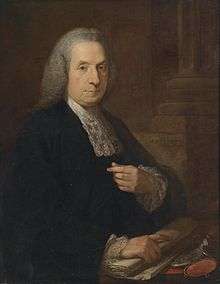Henry Singleton (judge)
Henry Singleton (1682–1759) was an Irish judge, remembered now mainly for his friendship with Jonathan Swift, and for his impressive acts of charity during the Great Irish Famine of 1740-1. Singleton House, his impressive townhouse in Drogheda, no longer stands.
Career
He was born in Drogheda, one of eleven children of Edward Singleton, Member of Parliament for the town and his wife Catherine Newton. He went to school in Drogheda, graduated from the University of Dublin and was called to the Bar in 1707. Like his father he sat in the Irish House of Commons for Drogheda and narrowly missed becoming Speaker; he was also Recorder of Drogheda and became Prime Serjeant in 1726. He evidently found the office of Serjeant an onerous one, judging by his later pleas to be appointed to "a place of greater ease". It is interesting that he assumed that the workload of a judge would be lighter than that of his present office.
In 1739, when the office of Lord Chancellor of Ireland fell vacant, Singleton lobbied hard for it, arguing that what he described as his "fifteen years of faithful service to the Crown" surely entitled him to "a place of more ease, though less profit, than his present situation".[1] There was however a great reluctance on the part of the English Crown to appoint any Irish-born judge as Lord Chancellor,[2] and he was passed over in favour of Robert Jocelyn, 1st Viscount Jocelyn, [3] but was raised to the Bench as Chief Justice of the Irish Common Pleas in 1740.[4]
Within a few years his health began to fail, although he made frequent visits to Bath and Spa in the hope of a cure. Despite pressure from William Yorke, his nephew by marriage, who was anxious to succeed him, he was reluctant to step down. Eventually in 1753 he resigned as Chief Justice; the following year he became Master of the Rolls in Ireland which was (then largely a sinecure rather than the senior judicial office which it became later). He held the Mastership until he died, unmarried, in 1759.
Heirs
His will contains a long list of legacies to his surviving sisters, and to his numerous nephews and nieces. The principal beneficiary was his niece Mary, daughter of his brother the Rev. Rowland Singleton, vicar of Termonfeckin, and Elizabeth Graham (and sister of Charity Yorke). Mary married Philip Tisdall, Attorney General for Ireland from 1760 to 1777, who was a dominant figure in the Irish Government for many years.[5]

Residence
In 1731 he built an impressive residence named Singleton House at Laurence Street, Drogheda.[6] It has been described as a three story mansion of red brick, with seven bay windows and magnificent oak-panelled interiors. It became derelict in the 20th century, and was demolished in 1989.[7]
Character
Despite a rather haughty manner, which led to his nickname "the Prime Serjeant Grand", [8] Singleton was loved and respected by all of those who knew him well. He enjoyed the friendship of Jonathan Swift, who called him "the first of the worthiest" and appointed him his executor.[9] Yorke, his successor as Chief Justice, even while nudging him towards retirement, had nothing but praise for Singleton both as a man and a judge. The best tribute to his character is his noble behaviour during the Great Famine of 1740 when he donated much of his personal fortune to the relief of the poor of Drogheda.
References
- ↑ Hart, A. R. A History of the King's Serjeants-at-law in Ireland Dublin Four Courts Press 2000
- ↑ Philip Tisdall, Henry's nephew by marriage, was later passed over for the Chancellorship solely on this ground.
- ↑ Who as Attorney General for Ireland since 1730 clearly had at least an equally strong claim to it, apart from being English by birth- see Hart Serjeants-at-law
- ↑ Hart Serjeants-at-law
- ↑ Registry of Deeds Dublin Abstracts of Wills Vol. 2
- ↑ "Houses of Yesteryear in Mell" Drogheda Independent 21/01/2005
- ↑ "Memories of Freeschool Lane" Drogheda Independent 10/09/2004
- ↑ A View of the Bar 1730, anonymouss
- ↑ Ball, F. Elrington The Judges in Ireland 1221-1921 John Murray London ,1926
| Preceded by James Reynolds |
Chief Justice of the Irish Common Pleas 1740-1753 |
Succeeded by Sir William Yorke, 1st Baronet |